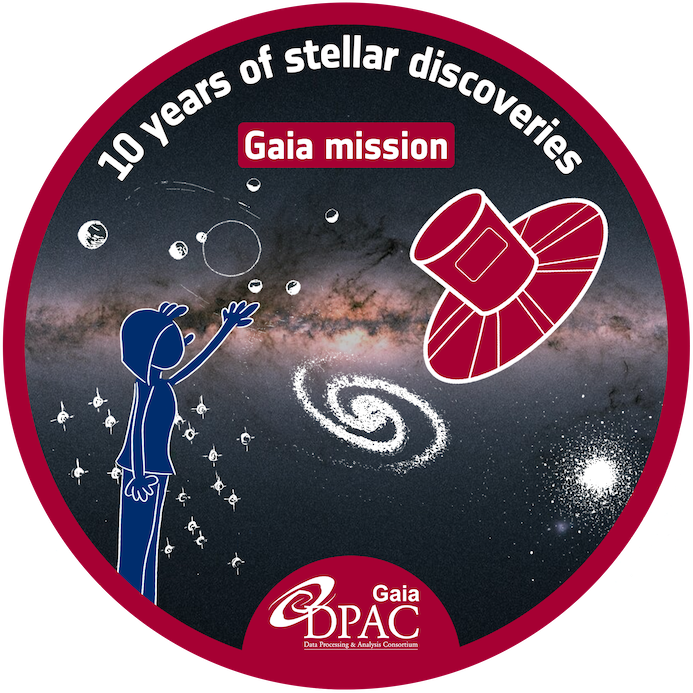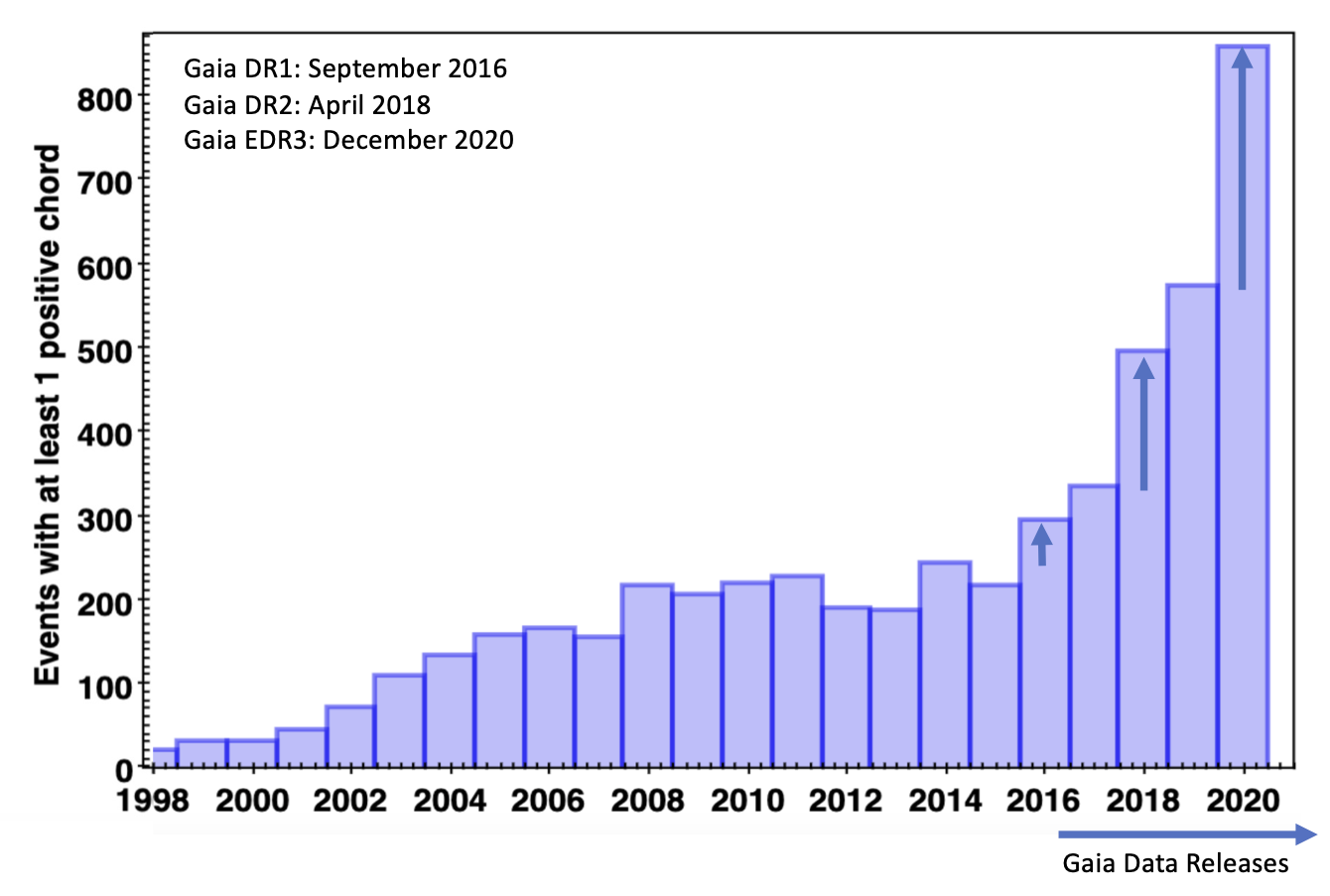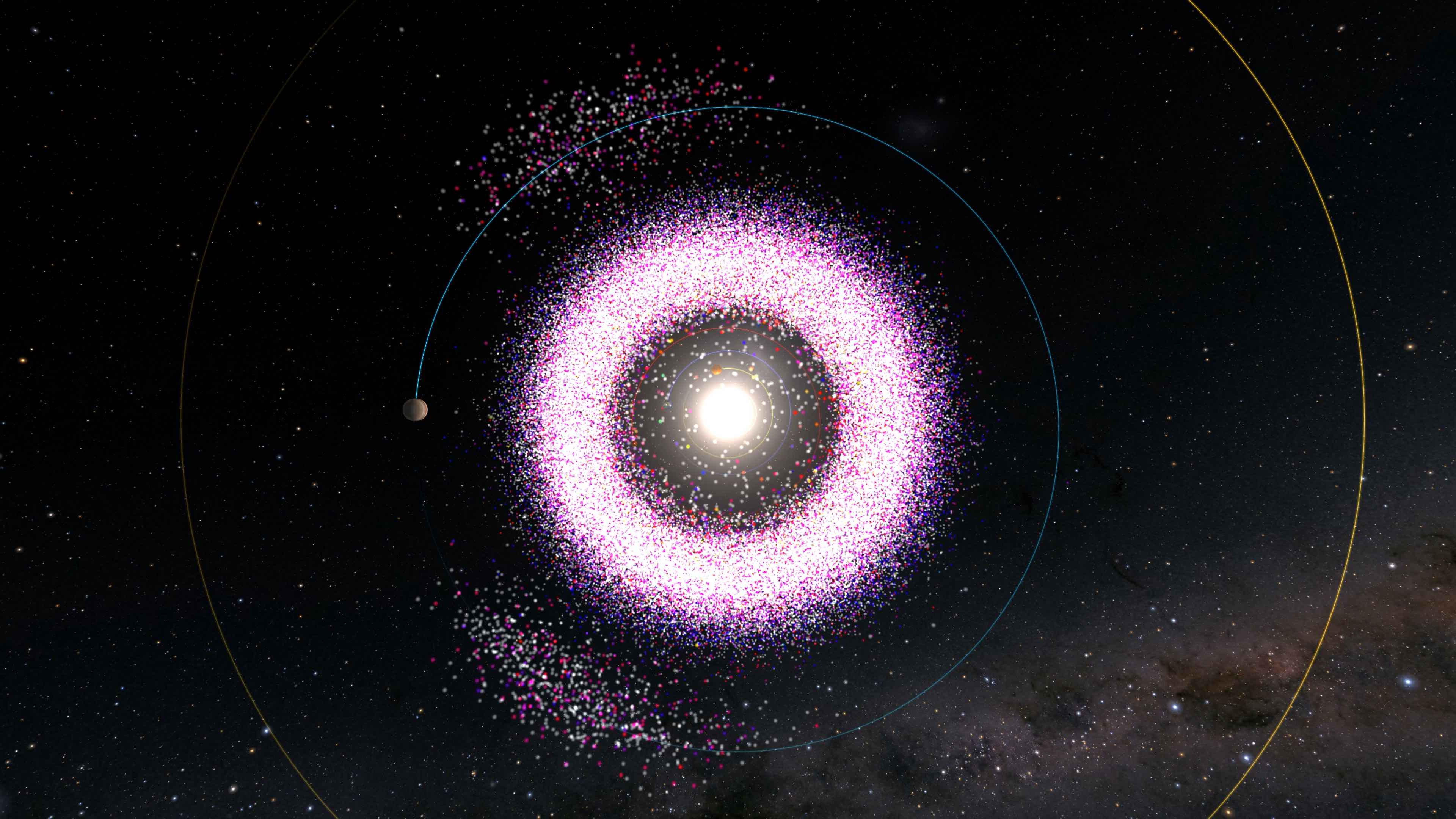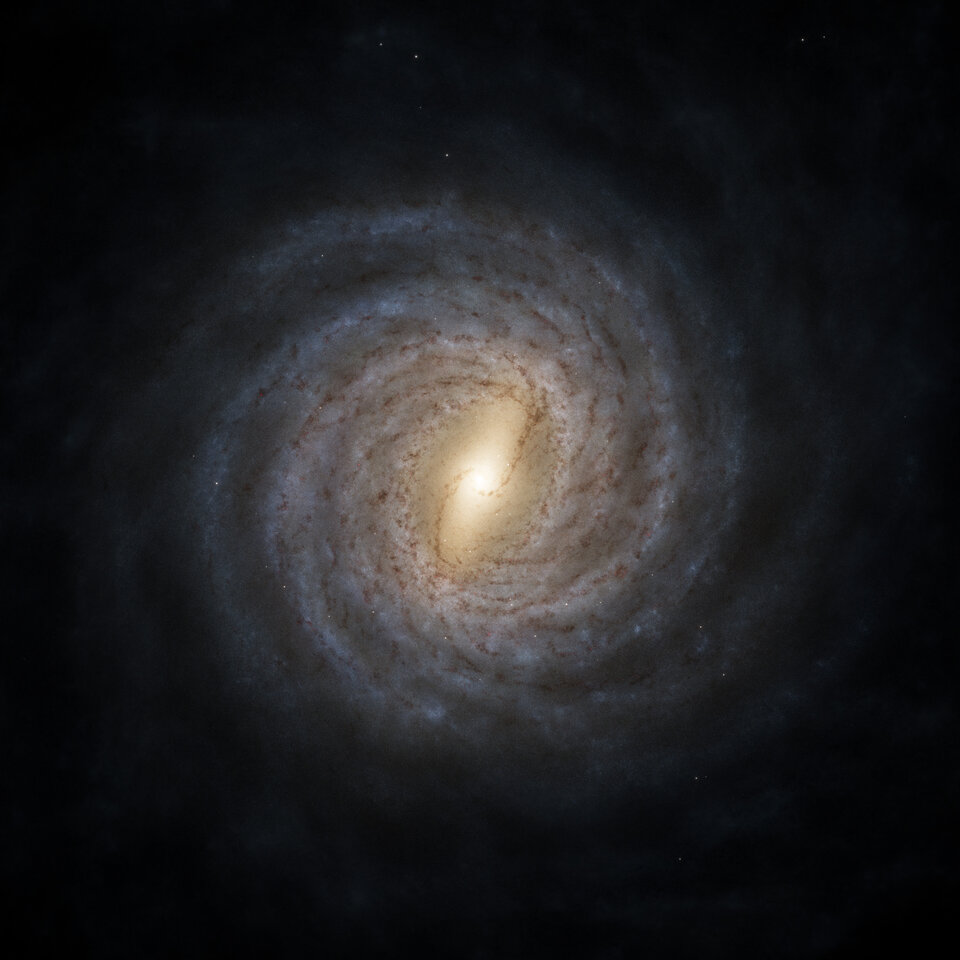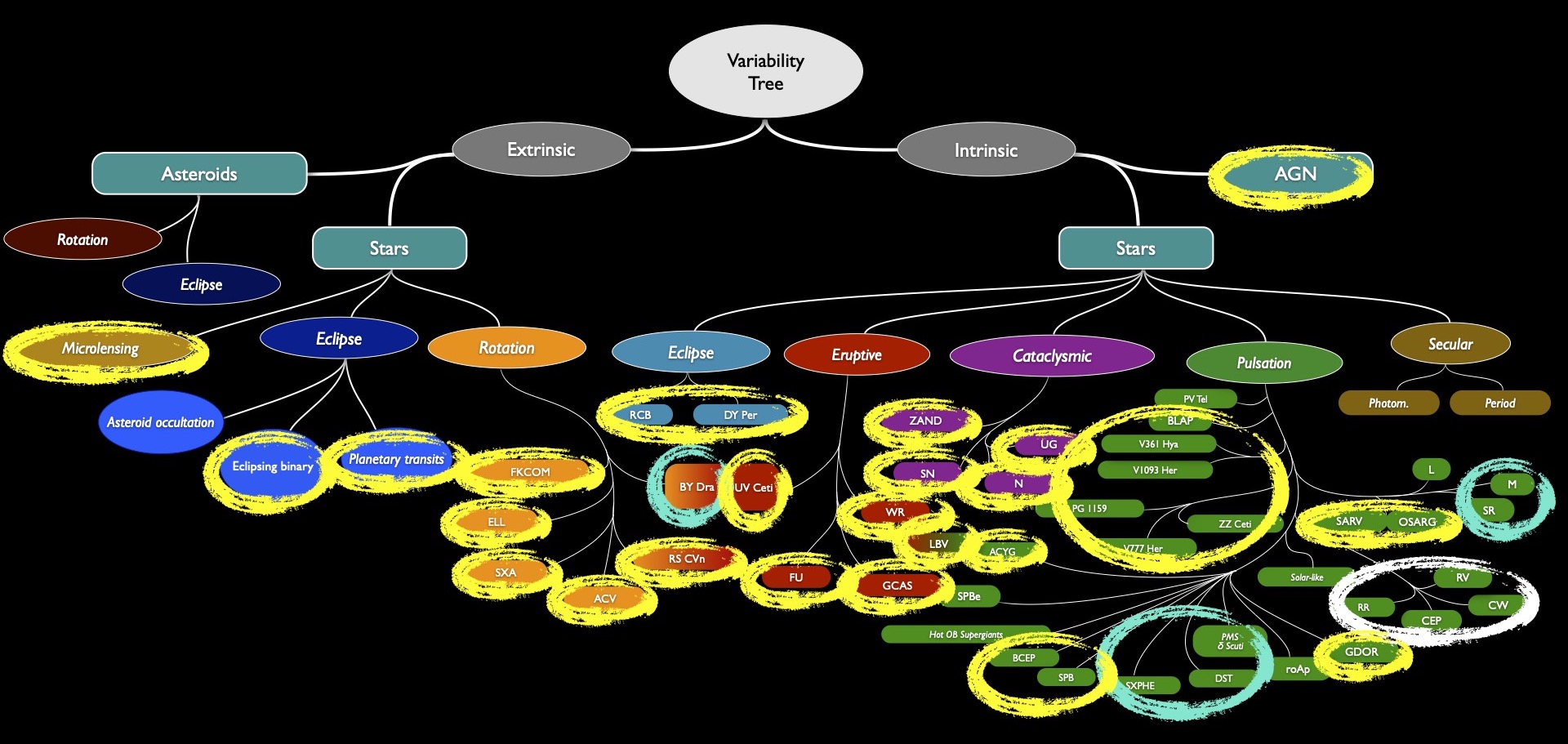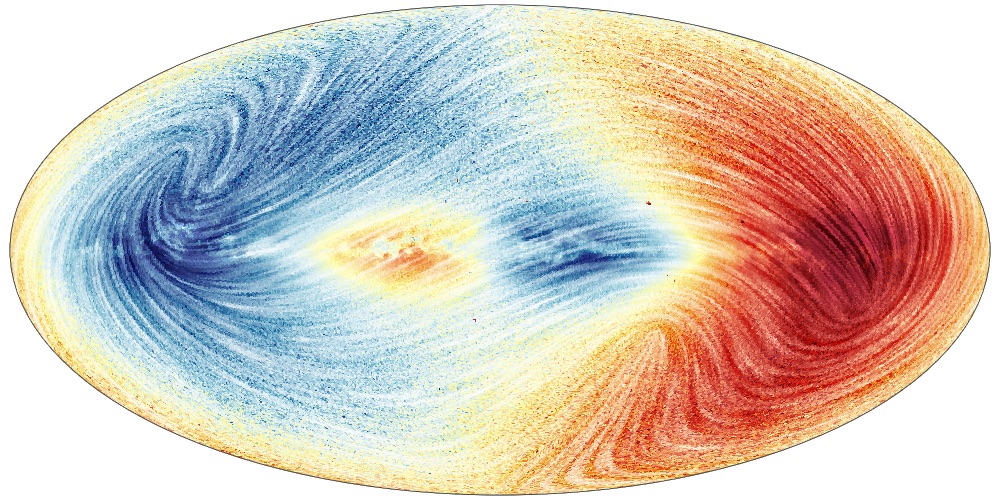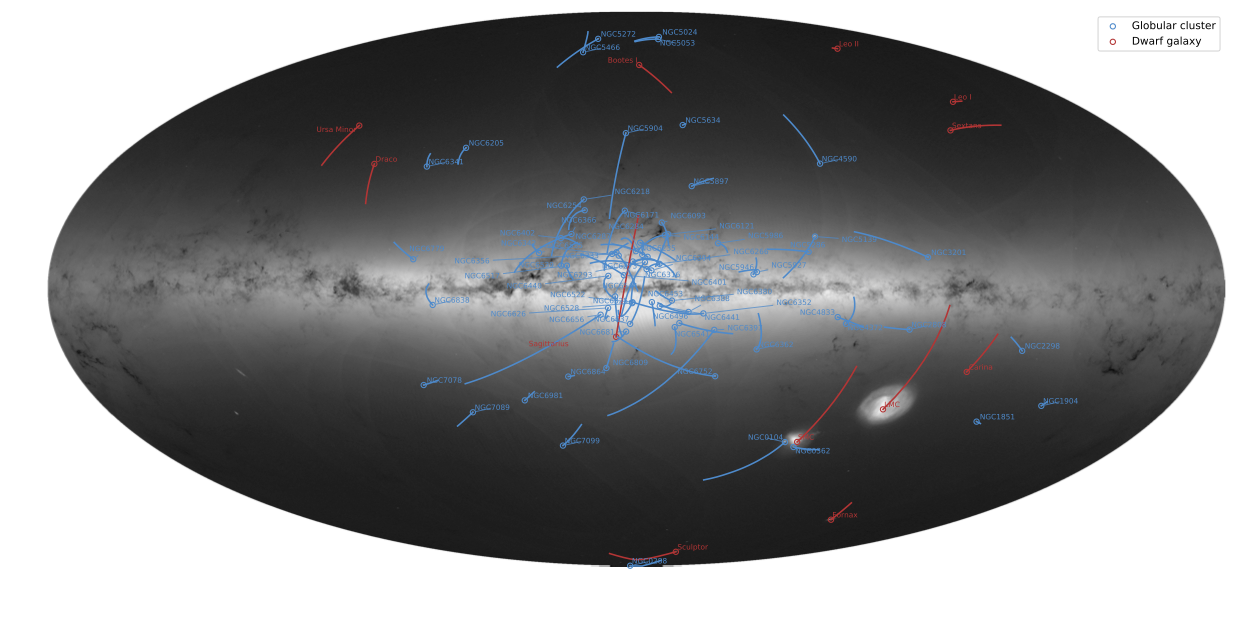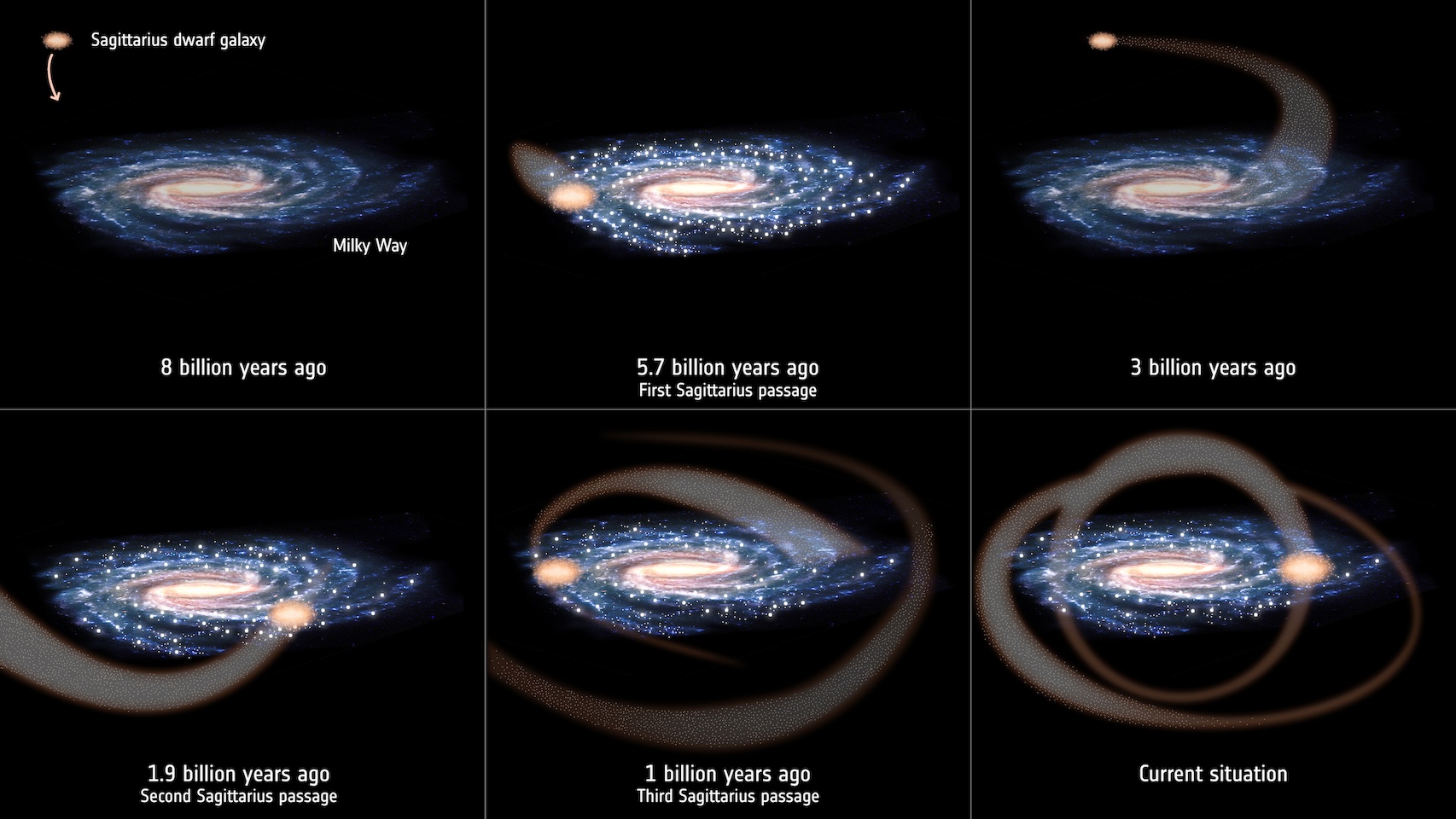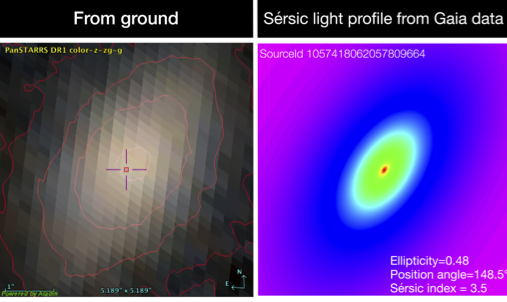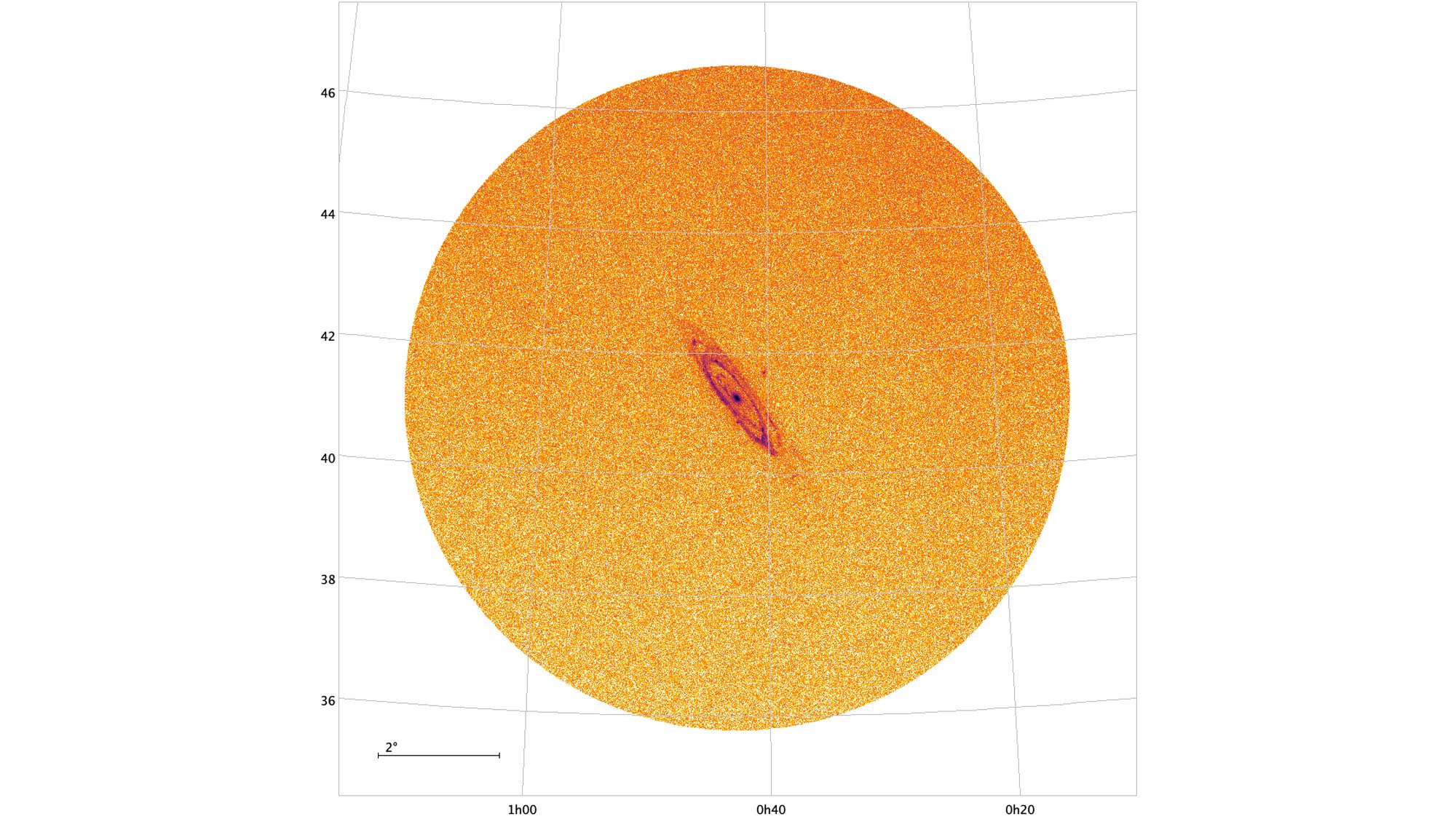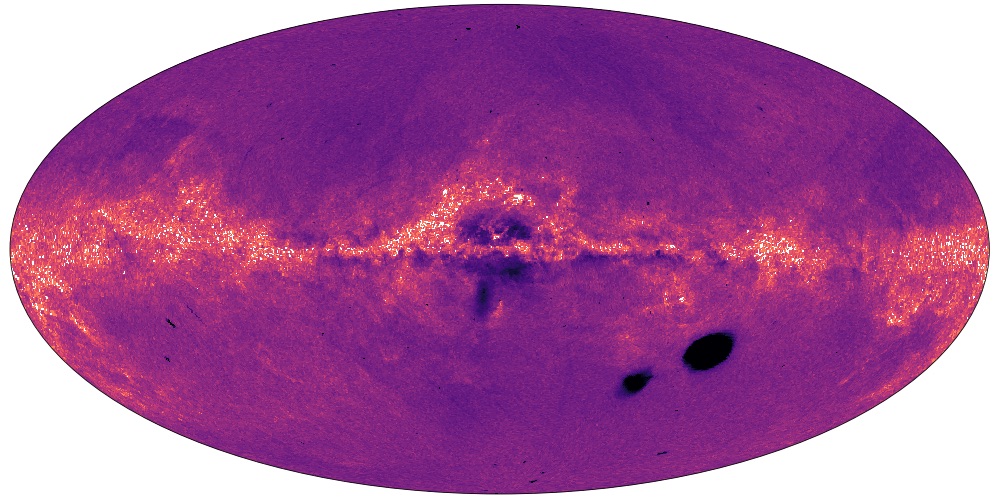IoW_20231219 - Gaia
Image of the Week
10 Science topics to celebrate Gaia's 10 years in space |
 |
stellar occultation asteroids and moons
spiral arms and structure stellar companions
special stars stellar DNA 3D motion
Milky Way satellites Gaia's galaxies cosmology with Gaia
Infographic on Gaia's 10 years in space, as published here. Credits: ESA, CC BY-SA 3.0 IGO
1. Earth: stellar occultation
If you love studying asteroids, and you’re doing so from Earth with your telescope, you might be interested in the opportunity to see an asteroid move in front of a star. This phenomenon is known as a stellar occultation and refers to the moment an asteroid or moon temporarily blocks the light of a far-away star by moving in front of it. A shadow path on Earth is formed and when positioned in this shadow path at the right time, the short moment the star’s light is blocked can be observed. A rare opportunity to study the asteroid’s shape, rings, and many of its other properties.
Until recently, the predicted shadow path on Earth was less certain and this increased the area on Earth where the shadow path could be located. Many observers had to be spread over the larger predicted shadow area in hopes to capture the occultation. The organizational aspects of such a campaign could be quite challenging, especially when it required observing from remote locations on Earth or when the predicted shadow path is located over the oceans for example. Equally, the timing of the moment the asteroid would move in front of the star wasn’t known very well either, which meant you better keep looking through the telescope for a longer period or else you might miss the star blinking away.
With Gaia’s Data Release 1, a first improvement to this field became visible. To predict such a shadow path on Earth, one needs to know the position and motion for both star (the one that is occulted) and the asteroid (the one that will occult the star) with enough detail. Here is where Gaia helps. Gaia determines the positions and motions of many stars in our Milky Way, and with its first release, immediately the field transformed. The predicted area for potentially capturing the occultation started shrinking, and has been shrinking ever since with each new Gaia data release.
With better star positions and improved star motions, the predictions improved and the uncertainties dropped. Thus, increasing the chances of the observers of capturing this special phenomenon. This effect is clearly seen in the below figure. A. first small jump is seen with Gaia DR1 but the effect of the following two data releases was even more distinct.
Adaptation of figure 1 of Ferreira et al. 2022.
With its star data, Gaia has helped indirectly many solar system studies on Earth succeed. Some of the advances seen are for example the improved knowledge on the Yarkovsky acceleration, the study of asteroids with rings like Chariklo and the study on the shape and improved location of a Kuiper Belt Object (target of the NASA New Horizons mission). Gaia also allowed studies of the atmosphere of Neptune's largest moon Triton and capturing a Near-Earth Object like Didymos (target of the DART mission) as well as observations of Jupiter's moon Europa and much, much more. With the increased number of stellar occultation observations, the field of occultation astrometry is opening up.
Chasing a stellar flash - published here. Credit: ESA.
Credits: Story written by Tineke Roegiers
2. Solar system: asteroids and moons
The Gaia space mission is primarily designed to create an exceptionally detailed stellar catalogue by mapping the positions, parallaxes, and proper motions of over a billion stars in the Milky Way and beyond. Despite its primary focus on stars, Gaia has proven to be a valuable asset in the detection and characterization of Solar System Objects (SSOs), including asteroids and planetary moons. In fact, while Gaia's mission design was not originally optimized for SSO detection, its systematic measurements have provided positions that are a hundred times more precise than those obtained in previous decades. This allows to deduce precise orbits for over 156,000 asteroids with Gaia.
Overview of asteroids in Gaia's Focused Product Release. Credits: ESA/Gaia/DPAC - CC BY-SA 3.0 IGO. Full details here.
When Gaia searches for asteroids, it compares calculated positions of selected asteroids with Gaia's data, considering the exact time of each observation to confirm matches. A dedicated team for Solar System Objects in Gaia's Data Processing and Analysis Consortium takes care of this task. This process not only allows to make the previously measured data more accurate but also identifies a list of 'unmatched asteroids', potentially leading to the discovery of new objects within Gaia's extensive dataset.
Gaia's past observations, such as Gaia's Data Release 2 in 2018 and Gaia's Data Release 3 in 2022, showcased high-quality data on solar system objects, including epoch astrometry and photometry. A special data set was released as well with reflectance spectra for over 60,000 asteroids. The largest such data set existing for asteroids! This data set allows to study asteroid families in more detail which in turn helps us understand the formation of our Solar System.
With Gaia's Focused Product Release on 10 October 2023, orbits for nearly 157,000 asteroids were significantly improved. These new orbits, based on up to 5.5 years of Gaia data, outperform decades of ground-based observations in terms of precision. To illustrate this, an asteroid named 'Wolfratshausen' with a five-kilometer diameter is focused on. By comparing pre-Gaia ground-based observations with Gaia's data, it can be seen clearly how Gaia's precision revolutionizes our understanding of asteroid orbits. The green cloud of asteroid positions in Gaia's data is remarkably compact, highlighting the progress made in just 5 years compared to 31 years of pre-Gaia observations. Credits: ESA/Gaia/DPAC - CC BY-SA 3.0 IGO. Published here.
The release of Gaia Focused Product on October 10, 2023, marked a significant leap forward, providing data for approximately 157,000 SSOs over a longer observation period of 66 months. This extended timeframe represents a significant improvement since it enabled the measurement of full orbits for most asteroids, resulting in orbits 20 times more precise than those in Gaia Data Release 3.
Infographic highlighting the contents of the Gaia data releases with respect to solar system objects. Full details as published here. Legend with explanation on the symbols used can be found here. Credits: ESA/Gaia/DPAC - CC BY-SA 3.0 IGO.
Apart from directly measuring asteroids with Gaia, the exquisite star data by Gaia helps improve many other asteroid orbits, asteroids never seeen by Gaia. Gaia has this impact because observations of asteroids are made against a backdrop of stars. The stars form a reference frame for the observations. The better the reference frame, the better the observation can be retrieved. Many older observations were revisited and positions of asteroids were rederived following Gaia's release of its star data. This indirect help from Gaia has improved many asteroid orbits and has even helped to retrieve lost asteroids.
So beyond its direct impact on solar system research, Gaia's precision measurements also contribute to protecting Earth from potential asteroid impacts and aid in the mission planning for space probes exploring SSOs. In essence, while Gaia's primary mission revolves around stars, its observations play a crucial role in advancing our understanding of the solar system's formation, structure, and evolution
But the Gaia mission doesn't stop here … Future expectations include Gaia's Data Release 4 with twice as many asteroids (~350,000) and additional data types, such as spin, shape parameters and precise masses of the largest asteroids. Gaia's continuous improvement in data precision and coverage promises more discoveries and insights into the solar system's structure and dynamics.
Further reading:
- Gaia revolutionises asteroid tracking
- 30 000 near-Earth asteroids discovered and rising
- Potential asteroid discoveries by the ESA Gaia mission
- Is it an asteroid? - The objects in our Solar System seen by Gaia
- Gaia Focused Product Release - Unlocking the secrets of solar system objects - Gaia's surprising role
Credits: Story written by Mariasole Agazzi and Tineke Roegiers
3. Milky Way: spiral arms and structure
A detailed overview story on the Milky Way, its structure and dynamics has been prepared in collaboration with Paul McMillan of the University of Leicester, member of the Gaia Data Processing and Analysis Consortium. This overview story can be accessed with the link below.
Read ESA's story here: Gaia’s decade of discoveries: unravelling the intricacies of our galaxy
Artistic impression of the Milky Way - face-on, based on the latest Gaia data. Credits: ESA/Gaia/DPAC, Stefan Payne-Wardenaar - CC BY-SA 3.0 IGO.
The story was based on many science results from the past years. It is impossible to provide a complete list of the most important results and papers that appeared over the past years. Gaia's library of peer-reviewed publications can be used as a starting point to find a lot of additional information on these topics. This library contains now more than 10,000 papers published since Gaia's launch.
Credits: The overview story was written by Nicky Jenner, Paul McMillan and Giovanna Giardino.
4. Milky Way: stellar companions
Beyond the Visible: Gaia's Detection of Binary Stars, Dormant Black Holes, and Exoplanets. The vast all-sky Gaia catalogue is a treasure trove for discoveries, providing the largest ever catalogue of stars for detailed investigation. With Gaia data, different types of objects in proximity to stars can be detected, such as sources forming a binary star system, black holes, and extrasolar planets.
Binary Stars. Binary stars are stellar systems composed of two stars orbiting around their common center of mass due to the gravitational force acting between them. These systems are very common in the universe and constitute a significant part of the stars present in the Milky Way.
Remember one of the great classics of the late 1970s 'Star Wars: A New Hope’? This film opens on the surface of a special planet called Tatooine, which orbits a binary star. In fact, in the sky of the first scene, two luminous bodies are seen, as if there were two suns.
Gaia’s third data release (Gaia DR3) contains nearly 1 million binary stars, thereby dwarfing all existing catalogues of binaries that have ever been created in the past few centuries. Binary stars are crucial probes to study stellar structure and evolution, dynamics of stellar systems, calibration of astronomical scales, and extreme astronomical phenomena, significantly contributing to our understanding of the nature and evolution of the universe.
Sky-projected orbits of 335 binary stars determined by Gaia, shown to scale and ordered by increasing distance from the Sun out to 50 pc. The colour roughly corresponds to the source's colour as determined by Gaia with purple/blue indicating hot stars and white dwarfs, green/yellow indicating Sun-like stars, and red indicating cool low-mass stars. Credits: ESA/Gaia/DPAC - CC BY-SA 3.0 IGO. Published here.
Dark Companions. Gaia’s catalogue of binary stars has been used by astronomers to unveil several dormant black holes. This type of black hole is very hard to discover since, in addition to not emitting any light, they present an 'extra' challenge compared to black holes that occur in so-called X-ray binaries: their companion is a normal star that does not interact, for instance as mass donor, with the black hole except through gravity, which keeps the two bodies in orbit.
How was it then possible for Gaia to detect this type of dark companions?
The black holes were discovered by studying the movement of their companion stars: a tiny but still measurable 'wobble' in the movement of the stars in the sky indicated that they are orbiting a very massive object that is not seen in images in visible light. The dormant black holes detected so far are approximately ten times more massive than our Sun, allowing to deduce without doubt that they are black holes.
“The precision of Gaia’s data was essential for this discovery. The black holes were found by spotting the tiny wobble of their companion stars while orbiting around them. No other instrument is capable of such measurements”, says Timo Prusti, ESA’s Gaia project scientist.
The dormant black holes discovered thanks to Gaia are particularly unique: they are the closest ones to Earth. In fact, Gaia BH1 and Gaia BH2 are located, respectively, at 1560 light-years away from us in the constellation Ophiuchus and 3800 light-years away in the constellation Centaurus. In galactic terms, they reside in our cosmic backyard.
Gaia discovers a unique black hole, as published here. Credit: ESA/Gaia/DPAC - CC BY-SA 3.0 IGO. Video created with Gaia Sky.
Stars with exoplanets. When an exoplanet orbits its host star, tiny effects are induced by the presence of this celestial body. Although these effects are difficult to detect, requiring instruments with a high degree of precision, their recognition and measurement is crucial to detect extrasolar planets.
The observed changes for the star around which an exoplanet revolves depend on the type of detection method that is used. Among them are a periodic shift in the star’s spectrum (radial velocity), a periodic wobble in the star’s position (astrometry), or a temporary and periodic dimming of the star’s light when the exoplanet passes in front of it (transit). Gaia, thanks to her precision, can detect the presence of thousands of exoplanets accurately monitoring changes in the host star using all three methods, with the astrometric technique being most novel and unique.
With Gaia Data Release 3, it has been possible to publish a list containing the first Gaia exoplanet candidates mostly based on the photometric transit method. Recently, thanks to a synergy with data from the ESA Hipparcos mission, several extrasolar planets have been discovered through astrometry. The Gaia exoplanet candidate catalogue currently counts 214 exoplanet candidates discovered with Gaia’s astrometry. Tens of thousands of (candidate) detections are expected with Gaia Data Release 4 (Gaia DR4).
It is important to note that Gaia's role in the field of extrasolar planet research is not limited solely to the detection of exoplanets. The information provided by Gaia about the host stars themselves is also crucial. From the characteristics of the host star, it is possible to deduce important information about the planet, such as its radius. There is thus a direct connection: by improving knowledge of the host star, one can learn more about the planet(s) orbiting it.
Further reading
- How Gaia detects binary stars
- Is it a double star? - Discover Gaia's non-single star catalogue
- Did something move in front? - Gaia's exoplanets and host stars in Gaia DR3
- Gaia discovers a new family of black holes
- Astrometric orbit of the exoplanet-host star HD81040
Credits: Story written by Mariasole Agazzi in collaboration with Jos de Bruijne and Tineke Roegiers
5. Milky Way and beyond: special stars
When stars are mapped thoroughly, like Gaia does, many special stars pop out. Some explode, some experience starquakes, and some are very rare! Some might undergo a peculiar brightening or dimming caused by microlensing or perhaps by them being a pulsating star. There are many causes to a star showing a peculiar behaviour, and Gaia’s Data Processing and Analysis Consortium has dedicated teams to disentangle the nature of each curious incident in the Gaia sky.
Nonradial oscillation modes cause a star's surface to move while it rotates, as shown in the animation. Full details on this animation can be found here. Animation Credit: ESA/Gaia/DPAC - CC BY-SA 3.0 IGO.
With Gaia’s Data Release 3 it was clear that Gaia is so sensitive, that it can measure starquakes as well. Starquakes are nonradial oscillation modes of stars, a bit like large-scale tsunamis. The different modes seen in stars can reveal information on their inner workings. The field of asteroseismology with Gaia opens up. There is also the occasional outburst for a very special type of star, like the time Gaia captured the outburst of a rare FU Orionis star...
Combining data can be useful to find the needles in the haystack. For example when Gaia data was combined with data from the Zwicky Transient Facility, a new type of binary star was finally found providing the link between Cataclysmic Variables and Extremely Low-Mass White Dwarfs, the so called pre-ELMs.
For some of the stars in Gaia’s field of view, their light is split because it passed a heavy object. This splitting causes a brightening of the background star which is picked up when processing Gaia’s photometry. A sudden brightening is alerted to the scientific community through the Gaia Photometric Science Alerts, to allow the community to follow up on the event. One such event with much follow-up is Gaia16aye. It was a special case since after the initial brightening, the star brightness did not suddenly drop, it was brightening up again a few weeks later. Unusual and hence very interesting. Turns out there was not only one background star, but a stellar pair!
Animation of the 363 microlensing events in Gaia's Data Release 3. Credit: ESA/Gaia/DPAC - CC BY-SA 3.0 IGO. As published here.
Then there are those stars that are very, very fast. The so-called hypervelocity stars. New ones were detected following Gaia’s data releases; after Gaia DR1: “Close encounters of the stellar kind”, after Gaia DR2: “Gaia spots stars flying between galaxies”, Hypervelocity white dwarfs in Gaia data, or even more after Gaia DR3.
So far, Gaia has published catalogues for 24 types of variable stars, many of them the largest ones existing to date. Improved and expanded catalogues can be expected with Gaia’s data release 4.
Gaia’s variability tree, showing the large variety of variable stars, split in two main groups: intrinsic and extrinsic. On this tree many variability types are highlighted with different colours. When highlighted with white, these variability types were published for the first time in Gaia’s Data Release 1. The cyan ones were added with Gaia’s Data Release 2. The many yellow types were added with Gaia’s Data Release 3. Credits: Gaia Collaboration, Eyer et al. 2019; adapted from L. Eyer & N. Mowlavi (03/2009) - CC BY-SA 3.0 IGO. As published here.
6. Milky Way and beyond: stellar DNA
Video highlighting the Gaia DR3 chemical cartography. Credits: ESA/Gaia/DPAC – CC BY-SA 3.0 IGO. Full details on this topic and the video here.
Picture a scenario where stars possess their unique genetic code, a celestial DNA capable of revealing the mysteries of their cosmic heritage. Surprisingly, this comparison is not implausible: like human DNA, the chemical composition of stars serves as the crucial element for discovering the complex history of the Milky Way.
The Gaia mission has emerged as a celestial detective, measuring the chemical fingerprints of stars across the Milky Way. In this context, Gaia’s Data Release 3 (Gaia DR3) provided crucial support in the creation of a chemical map of our galaxy. With millions of stars observed by the Radial Velocity Spectrometer (RVS) and their spectra analysed in detail, Gaia DR3 allowed to develop a spectral analysis of stellar populations.
What story do these chemical signatures describe?
Thanks to the data collected by Gaia, distinct birthplaces and interstellar journeys of stars that inhabit our galaxy have been detected. Old stars are mostly made up of the same components that formed the elemental constituents of the first stages of the universe: hydrogen and helium. In contrast, medium-age stars like our Sun, boast a lineage enriched by the legacies of preceding stellar generations. Their compositions reveal that they were formed with heavier elements – classically referred to as metals – produced by the life cycles and deaths of earlier stars.
Gaia's chemical cartography helps to track a dynamical picture of the Milky Way's evolution: the spiral arms stand out as metal-rich regions compared to the stellar landscapes outside them. The galaxy's composition emerges as a nuanced mosaic rather than a homogeneous blend.
The importance of these discoveries lies in the fact that the chemical composition of stars, revealed through their spectra, provides a fundamental understanding of their ages and origins. By discerning variations in the compositions, we can understand the details of the stellar nurseries in which they originated and, when combined with the motions measured by the Gaia, the interstellar regions they traveled through. Gaia's detections of the chemical elements serve as a historical record of stellar migration within our galaxy. The Milky Way, as Gaia portrays it, is a grand melting pot of stars.
"This diversity is extremely important because it tells us the story of our galaxy’s formation and evolution. It reveals the processes of migration of stars within our galaxy and of episodes of accretion of stars and gas clouds from external galaxies that were cannibalised by the Milky Way billions of years ago", says Alejandra Recio-Blanco, member of the Gaia collaboration.
The Gaia mission, and its data, has therefore made a fundamental contribution to our understanding of the Milky Way's chemo-dynamical history. Its rich dataset allows to explore the complexities of galaxy formation and evolution, showcasing the ever-changing interplay of stars and gases from diverse origins which compose today’s Milky Way.
Further reading
- The chemistry of our Milky Way
- Gaia sees strange stars in most detailed Milky Way survey to date
- What are stars made of - A chemical map with Gaia DR3
Credits: Story written by Mariasole Agazzi in collaboration with Jos de Bruijne and Tineke Roegiers
7. Milky Way and beyond: 3D motion
Celestial Kinematics: Gaia's Unprecedented Insight into Star Velocities. The Gaia mission uses a technique called astrometry which involves the precise measurement of the positions of celestial objects over time. The spacecraft is equipped with a highly sensitive camera capable of performing extremely precise measurements of star positions in the sky repeatedly taken over several years, allowing the determination of star motions.
At the same time, Gaia uses the principle of "stellar parallax" with the aim of measuring the distances of stars. As the Earth (and the Gaia space telescope) orbits the Sun, stars appear to slightly shift in the sky due to the change in perspective caused by our orbit: the closer the star, the larger the apparent shift. Measuring the size of these apparent shifts throughout the year, Gaia can measure the distances to stars. These data are fundamental because, combined with their annual angular displacement on the sky known as proper motion, distances enable the calculation of the tangential space velocities of stars in kilometers per second.
But it doesn’t end there, Gaia also employs the technique of spectroscopy to determine the radial velocity of stars, their space velocity along the line of sight. This information is obtained by measuring the Doppler shift of spectral lines in the spectrum of the star. Combining information about both tangential and radial velocities, Gaia provides an extremely accurate three-dimensional measurement of star velocities in the Milky Way, significantly contributing to understanding of the structure and evolution of our galaxy.
This sky map illustrates the measurements of the stellar velocities in the Milky Way using data from Gaia. Full details published here. Credits: ESA/Gaia/DPAC - CC BY-SA 3.0 IGO.
Gaia Data Release 3 (Gaia DR3) performs a crucial role in this field presenting the second version of a catalogue of radial velocities based on mean spectra collected during the first 34 months of the mission. This release is characterized by significant quality improvements and a more than four-fold increase in the number of stars: the mean radial velocities of 33,812,183 stars are included in Gaia DR3.
Using three-dimensional position and velocity mapping techniques, Gaia leverages crucial information also from objects such as stellar streams and stellar clusters. Analyzing the coordinated movement of stars in stellar streams — stars with a common origin that move together in space in an elongated structure as a result of tidal forces exerted by the Milky Way — Gaia provides insights into the dynamics of the galaxy, stemming from past interactions with infalling galaxies. Similarly, the study of stellar clusters — groups of stars formed in the same location, at the same time, and from the same molecular cloud — contributes to determining the structure and kinematics of the galaxy. These data enable a detailed understanding of evolutionary processes within the Milky Way, revealing fundamental aspects of galactic formation and evolution.
Finally, the study of star movements by the Gaia Mission is crucial because the motions of these bodies across the sky provide essential clues about objects that gravitationally influence them such as, for example, companion stars, exoplanets, and black holes.
Further reading
- Where do the stars go? Where do they come from? - Wavy proper motion patterns and the rotation of the Milky Way disk
- Do the stars approach us or do they move away? - The Gaia DR3 radial velocities bringing the third velocity component
Credits: Story written by Mariasole Agazzi in collaboration with Jos de Bruijne and Tineke Roegiers
8. Beyond the Milky Way: Milky Way satellites
Like planets orbit the Sun, and stars orbit the Milky Way’s supermassive black hole at the centre, dwarf galaxies orbit our Milky Way. Studying the motions of these dwarf galaxies and their interactions with our Milky Way help us understand the history of and the major events that shaped the Milky Way. The imprints of which we can still see at this very moment if carefully investigating the Gaia data.
The Milky Way as reconstructed from Gaia DR2 data, highlighting the location of nearly 90 satellites of the Milky Way: globular clusters (in blue) and dwarf galaxies (in red) with annotations. The arcs shown along with each satellite show the trajectories of the objects, and more specifically the path these objects take in the next 10 million years for the globular clusters (in blue) and in the next 100 million years for the dwarf galaxies (in red). Image created by Maarten Breddels. This image was published here with Gaia's Data Release 2. More on this topic also here.
With the kinematic information obtained by Gaia, systemic proper motions (the motion of the galaxy as a whole) could be computed for many of the galaxies in the Local Group. The Local Group is a structure in space containing both our Milky Way and the Andromeda galaxy with their satellite galaxies. Before Gaia's data release 2, when astronomers discussed the systemic proper motions in the Local Group, they were limited to the Magellanic Clouds, M31, M33 and a few other galaxies in our local neighbourhood. Now, thanks to Gaia, systemic proper motions can be computed for many tens of galaxies!
What can we learn from these? For one, the comparison of Gaia data and stellar evolution models allowed astronomers to deduce that the crashing of Sagittarius into the Milky Way might have triggered the formation of our very own Solar System. Or two, that stellar motions in the nearby Sculptor galaxy hint at underlying dark matter. Or... many more results for which you are referred to the Gaia library of peer-reviewed papers.
Sagittarius collisions trigger star formation in Milky Way, published here. Credits: ESA
And not only for satellite galaxies the impact from Gaia was felt... Thanks to Gaia the field of stellar streams exploded! Stellar streams are thought to be the remnants of galaxies torn apart by our Milky Way and stretched by tidal forces. These groups of stars orbit our Milky Way’s in their own specific way, and their path is now visible thanks to Gaia’s proper motions. Since Gaia’s data releases, many new stellar streams were found, and their origins traced back. Equally impressing results are seen for studies on globular clusters, all of which are helping us understand the many interactions shaping our home.
A tour through the Magellanic Clouds highlighting some results from Gaia Early Data Release 3. Credit: ESA/Gaia/DPAC - CC BY-SA 3.0 IGO.
Two of the most famous galaxy satellites of our Milky Way are the Large and Small Magellanic Clouds. Gaia observes the individual stars inside these galaxies and maps their position, 3D motion and chemical composition. With Gaia’s Early Data Release 3, the Gaia Collaboration made use of the LMC and SMC to demonstrate the quality of the data with a dedicated paper “Gaia Early Data Relesae 3: Structure and properties of the Magellanic Clouds by the Gaia Collaboration, X. Luri, et al. A&A 2020. Many beautiful visualisations were produced along with this release highlighting the LMC and SMC.
Credits: Story written by Tineke Roegiers
9. Beyond the Milky Way: Gaia's galaxies
Beyond the Milky Way… Beyond the satellites orbiting the Milky Way… There’s more… many more galaxies, and Gaia detects some of these as well. Gaia detection is based on an object being point like. For extragalactic objects this condition is reached when they are far away, or when the central part of the galaxy stands out on top of the extended emission. If the extragalactic object passes the detection threshold, then also the immediate extended emission of the galaxy is measured by Gaia. These observations undergo special processing, taken care of by the Extended Objects team in Gaia’s Data Processing and Analysis Consortium.
Gaia does not take pictures as some telescopes do. It obtains many 1D observations from various directions. Identifying galaxies from these observations is a complex task! A first catalogue of galaxies was published with Gaia’s Data Release 3 in June 2022. The data set contains over 4.8 million galaxy candidates!
While from ground, observations get blurred by the atmosphere. Gaia observes from the second Lagrange point in space and thus is not hindered by atmosphere or light pollution or weather. The results obtained from space are superb and allow to analyze the morphology of galaxies, and with that these galaxies disclose some of the secrets of their evolution.
Gaia has analysed all its observations and was able to measure its morphology corresponding to an elliptical galaxy positioned in the sky at 148° with respect to the North pole. Using the fitted parameters of the light profile given in the Gaia DR3, it is possible to produce a synthetic image of it. This object has also been photographed from Earth with PanSTARRS, which allows to compare these images: from the ground, the atmosphere blurs the image, while Gaia "sees" more precisely its shape. Of the 914 837 galaxies with morphology in Gaia DR3, 57% were not measured from the ground; Gaia explores a population of tiny galaxies never resolved from the ground. Credits: ESA/Gaia/DPAC – CC BY-SA 3.0 IGO, based on the paper "Gaia Data Release 3: Surface brightness profiles of galaxies and host galaxies of quasars" by Ducourant, et al. 2022. Full details in the story: "Is it a galaxy? - The galaxies in Gaia DR3".
If galaxies are close enough, Gaia even maps their individual stars. Think of the Andromeda galaxy (M31). It is the nearest galaxy to the Milky Way at 2.5 million light years from us. It’s mind-blowing that even at those distances, Gaia can still map individual stars!
The Andromeda galaxy is long suspected to be on a collision course with the Milky Way. Following Gaia’s data releases, astronomers investigated the behaviour of Andromeda and other nearby galaxies like Triangulum galaxy and computed their collision speed. Studying their kinematics and how they orbit one another can help us understand how galaxies form and merge. Two options existed: either the Triangulum galaxy already had fallen into Andromeda in the past, or we are witnessing the first infall. Gaia data points to this being the first infall. With each new Gaia data release, these predictions can be improved and our knowledge of the motions of our closest galaxies expand, hinting at what's to come when Andromeda finally collides with the Milky Way.
All the stars in the Gaia Andromeda Photometric Survey as published along with the story "How bright are the stars? - The Gaia DR3 magnitudes". Evans et al. 2022. CC BY-SA 3.0 IGO.
A special survey was published with Gaia’s Data Release 3, where full epoch photometry was released for all Gaia sources in the small region of the sky of Andromeda. A first insight of what is coming in Gaia’s data release 4.
Credits: Story written by Tineke Roegiers
10. Beyond the Milky Way: cosmology with Gaia
Cosmology? Indeed, it is not really Gaia’s main domain, and one might be mistaken to think that Gaia does not contribute to cosmology. Because it does, and more than you might think. There’s Gaia’s own quasars… there’s Gaia’s own gravitational lenses… and Gaia’s data also helps studying the expansion rate of the Universe, the much-debated Hubble constant.
When Gaia scans across the sky, it sees stars... but also many other objects out there that may be further away (like quasars at billions of lightyears from the Sun) or closer by (like asteroids or moons within our Solar system). Dedicated teams in the Gaia Data Processing and Analysis Consortium ensure the extragalactic content is dug out from the raw data and published in the Gaia Archive. With Gaia’s Data Release 3 a catalogue of more than 6,5 million quasar candidates was published, with redshifts determined for most of them. For a subset of about 64,000 also the host galaxy is detected by Gaia.
\Galactic sky distribution of all quasar candidates in Gaia Data Release 3, with more details on this data set published in the story "Is it a quasar? - The Gaia DR3 quasar candidates". Image credit: ESA/Gaia/DPAC- CC BY-SA 3.0 IGO, based on Gaia Collaboration, Bailer-Jones, et al. 2022.
Gaia uses quasars to determine its own Gaia optical reference frame, against which all Gaia observations are placed. Gaia’s Celestial Reference Frame is unique since it is built from optical observations only. It feeds into the International Celestial Reference System (ICRS) where the optical information from Gaia is combined with radio information from other observatories.
Following the publication of quasars in Gaia Data Release 3, a new catalogue called Quaia was constructed by the scientific community. While the Gaia Data Release 3 catalogue of quasars is highly complete, all-sky and homogeneous, the Quaia catalogue aims for a higher purity. The combination with unWISE infrared data allows to filter out contaminants, hence brings a cleaner selection quasar sample. This catalogue is useful for studying large-scale structures in the Universe.
The dark matter distribution in the Universe is also studied with the use of gravitational lenses. Just two months ago, Gaia published its first results from the search for gravitational lenses in the environment of quasars. Presented in Gaia’s Focused Product Release: 381 new lensed quasar candidates, most of them with two components, but with 5 especially rare cases as well, the so-called Einstein crosses having 4 components!
Infographic on Gaia's gravitational lenses as published with Gaia Focused Product Release in October 2023. Full details on this data set and this infographic can be found from the story "Gaia's gravitational lens candidates - how light surfs the waves of spacetime". Credits: ESA/Gaia/DPAC - CC BY-SA 3.0 IGO.
And then, of course, Gaia’s star data can help with the studying of the expansion rate of the universe. By smartly combining the Gaia catalogue of Cepheids with a search for open clusters, a 0.9% calibration was obtained for the Cepheids period-luminosity relation. With this relation more robustly known, galactic and extragalactic distances can be estimated more accurately. This is the contribution from Gaia in the first step of so called distance ladder to estimate the size of the Universe.
Currently a debate is ongoing in the scientific community about the weight of the Milky Way and the amount of dark matter it contains and how this dark matter is distributed. Different methods can point to different results, and sometimes results seen in the Milky Way do not match with the measurements obtained from external galaxies. This debate can be expected to continue for many years to come with better and better Gaia data.
Credits: Story written by Tineke Roegiers
Visual created by the the Art of Gueguel. Original creator of Gaia's fairing logo. The girl, Sharly, originally reaching for the stars at a young age, has aged along with Gaia these 10 years. Credits: The Art of Gueguel and Sharly.
Now, after 10 years, the impact of Gaia is clearly felt, though this is just the beginning of what Gaia can bring. We have not even seen its full power yet. Gaia’s data release 4 will bring, for the first time, full epoch data from its astrometric, photometric and spectroscopic instruments. Keep tuned for more news from Gaia.
Commemorating a decade of dedication, innovation, and scientific discoveries
Since its launch on 19 December 2013, Gaia has undertaken an incredible journey through the cosmos that has revolutionized our understanding of the Milky Way. Today, we are excited to celebrate the 10-year launch anniversary of this extraordinary mission by sharing a special video created by Chloé Carriere, aka Galactic Chloé, a science communicator based in Switzerland who was awarded the ESA Champion distinction for her YouTube videos.
This video not only celebrates the tenth launch anniversary but also provides a close and engaging look at some of the most spectacular scientific discoveries of the Gaia mission. Through Chloé’s keen eye, viewers can immerse themselves in the wonders of our universe. The video tells the story of Gaia revealing the secrets of the stars and pays tribute to the hundreds of dedicated individuals in the Gaia Data Processing and Analysis Consortium who are crucial in the production of the science-ready products that underly the more than 10,000 peer-reviewed scientific papers that the mission has generated so far.
Welcome aboard this extraordinary space science adventure! Fasten your seatbelts and get ready to be fascinated by this journey through the wonders of the cosmos under the guidance of a special little girl who is preparing to blow out the candles on her 10th birthday!
Credits: A collaboration between Chloé Carriere and the Gaia team with Mariasole Agazzi, Tineke Roegiers and Jos de Bruijne.
Gaia's data - Brought to you by Gaia DPAC
A celebration of the diversity of people behind Gaia - celebrating Gaia's 10 years in space. The ESA Gaia mission was launched on 19 December 2013 and is mapping the Milky Way with unprecedented accuracy. The data produced by the mission is processed by a large international collaboration: the Gaia Data Processing and Analysis Consortium. The mission has published several data releases and more are on the horizon.
Video highlighting the people from Gaia DPAC. Acknowledgements: Anthony Brown, Dafydd Evans, Céline Reylè, Giorgia Busso, Panagiotis Gavras, Sara Jamal, Zusanna Kostrzewa, Tomaz Zwitter Editing: Federico Di Giacomo, Rosanna Sordo, Tineke Roegiers. Spacecraft footage: ESA. Data visualizations: Gaia Sky - ESA/Gaia/DPAC. Drawing: The Art of Gueguel and Sharly. Planets visualization: NASA. Music: Dusk Till Dawn. ESA/Gaia/DPAC - CC BY-SA 3.0 IGO
Credits: Video produced by Federico di Giacomo and Rosanna Sordo from Padova University.
A special anniversary logo for the ESA Gaia mission
A competition for a celebration logo was held in the Gaia Data Processing and Analysis Consortium, in honour of the ESA Gaia mission's 10 years in space. The winning logos from Mariasole Agazzi and Albert Masip Vela were merged in collaboration with Federico di Giacomo and Rosanna Sordo. The result showcases the girl from the original Gaia fairing logo, aged along with Gaia, and in the background the Gaia sky in colour. Depicted are the different areas touched by Gaia: the Solar System and the Milky Way but also galaxies beyond the Milky Way... Credits: ESA/Gaia/DPAC
Celebrations everywhere!
Across Europe, Gaia teams from both ESA and DPAC celebrated Gaia's 10 years in space. This special Gaia cake was created by Nicole Jung from ESOC for the celebrations in Germany organised by Gaia's Flight Operations Team.
Credits: ESA/Gaia/DPAC
[Published: 19/12/2023]
- Removed a total of (97) style text-align:center;
- Removed a total of (1) style text-align:left;
- Removed a total of (95) style text-align:justify;
- Removed a total of (1) border attribute.
- Removed a total of (1) cellpadding attribute.
- Removed a total of (1) cellspacing attribute.
Image of the Week Archive
- Removed a total of (1) border attribute.
- Removed a total of (1) cellpadding attribute.
- Removed a total of (1) cellspacing attribute.








































 Sign in
Sign in
 Science & Technology
Science & Technology
